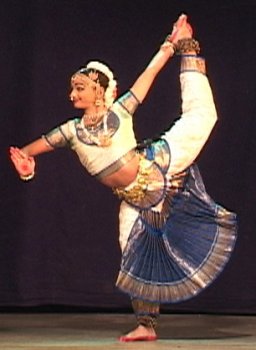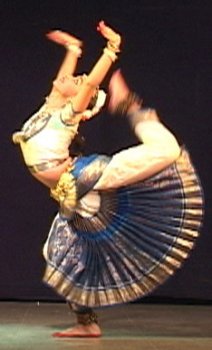 |
 |
Maintaining a competitive edge is key to winning the hearts of rasikas - Uma Balasubramaniam January 27, 2009  Why
do most dancers performing in early January see nearly empty auditoriums?
The 7th of January offered 11 dance programs (apart from quite a few music
concerts) taking place at the same time. There were solo Bharatanatyam
recitals by Malini Srinivasan, Priya Venkatraman, Suma Mani, Shradha Balu,
a ballet by students of Ranganayaki Jayaraman, a group performance by students
of Parvathy Mohan, another by the students of Swaralaya, yet another by
dancers of Bharata Kalanjali, a Kuchipudi recital by Deepika Reddy and
an Odissi performance by Sujata Mohapatra. The 11th dance program was a
Bharatanatyam solo that, surprisingly, attracted over 150 rasikas to Rama
Rao Kala Mandapam who came to watch a recital by Harinie Jeevitha, a student
of Sheela Unnikrishnan. Why
do most dancers performing in early January see nearly empty auditoriums?
The 7th of January offered 11 dance programs (apart from quite a few music
concerts) taking place at the same time. There were solo Bharatanatyam
recitals by Malini Srinivasan, Priya Venkatraman, Suma Mani, Shradha Balu,
a ballet by students of Ranganayaki Jayaraman, a group performance by students
of Parvathy Mohan, another by the students of Swaralaya, yet another by
dancers of Bharata Kalanjali, a Kuchipudi recital by Deepika Reddy and
an Odissi performance by Sujata Mohapatra. The 11th dance program was a
Bharatanatyam solo that, surprisingly, attracted over 150 rasikas to Rama
Rao Kala Mandapam who came to watch a recital by Harinie Jeevitha, a student
of Sheela Unnikrishnan.
Harinie's opening item, Ganesha Kautuvam in ragam natai and adi talam, was full of refined sculpturesque poses, intricate movements and high jumps that her supple body performed with ease, delineating each curve and bend with precision. While many dancers hardly lift their heels or hardly lift their feet while doing fast steps, Harinie's feet moved fully and sharply, making her salangai produce a variety of sounds. The next item was Annamacharya's kirtanam "Vande Vasudevan" in sri ragam and kanda chapu talam, where Harinie's expressions brought out the depth of bhakti and the devotee's perceptions of the Lord. Varnam "Aadal Nayagam," composed by Madurai R. Muralidharan in kalyani ragam and adi talam, was full of difficult adavus where Harinie accentuated each beat with sharp movements of her chin and her eyes. Each jathi was choreographed in a distinct manner. The varman had a lot of surprises for the spectators in its complex and fast nritta passages that contained a large number of the most difficult karanas. "The karanas are here not merely for a spectacular aesthetic effect," commented Sheela Unnikrishnan, "they are here to evoke the spirit of Nataraja." These fast changing difficult poses and acrobatic karanas require extraordinary balance and raised a storm of applause every time they were seen. However Harinie should polish some passages before presenting them on the stage, as freezing in a difficult static pose right in the middle of a very fast paced passage is a tremendous challenge to any dancer. The theermanams themselves contained only 3 steps, much fewer than the average, much to the delight of those rasikas who cannot digest the ornamentalism of Shobana's overstretched 20-step-long theermanams. Actually, Aadal Nayagam's theermanams themselves did not end in the customary manner but with a brief scuplturesque sequence of nritta.  Papanasam
Sivan's "Ka Va Va" in varali ragam and adi talam was the fourth item. It
began - and ended too - with portraying a devotee eagerly waiting for the
Lord to appear. It was a pleasant surprise to see such a young dancer convey
the spiritual significance of such spiritually significant passages faithfully.
Harinie's abhinaya, with a rich palette of bhavas, was candid and touching.
She was the very embodiment of Shiva's nature in the scene of Shiva burning
Manmadan. Her long fingers lent an exquisite artistic touch to each "plain"
action. Papanasam
Sivan's "Ka Va Va" in varali ragam and adi talam was the fourth item. It
began - and ended too - with portraying a devotee eagerly waiting for the
Lord to appear. It was a pleasant surprise to see such a young dancer convey
the spiritual significance of such spiritually significant passages faithfully.
Harinie's abhinaya, with a rich palette of bhavas, was candid and touching.
She was the very embodiment of Shiva's nature in the scene of Shiva burning
Manmadan. Her long fingers lent an exquisite artistic touch to each "plain"
action.
While Harinie was portraying a devotee pleading with the Lord, each repetition of the same line brought about a visibly different variation in her abhinaya. Some passages were performed with a childlike abandon and innocence, which was particularly handy while portraying delicate coyness. Such uninhibited abhinaya has the power to convince and move the spectators' hearts and minds. She was masterful at drishya bhedas, her eyelids impeccably following the tune and the rhythm. She moved smoothly and effortlessly between the semi-standing to sitting positions, without any unnecessary moves. The concluding item was Dr. M Balamuralikrishna's thillana in Kathanakuthukalam ragam. It was full of complex nritta and sculpturesque poses. Harinie's long and flexible fingers assumed the impeccable nritta hasthas at the right moments. Her mukha abhinaya was in harmony with the movements of her limbs, her face sparkling with myriad harmonious and spontaneous expressions. The thillana ended with a "trademark" pose characteristic of the dancers of Sri Devi Nrithyalaya. One of the rasikas, Bharatanatyam dancer Anita Sivaraman (granddaughter of Papanasam Sivan), concluded, "Harinie is obviously an extremely talented dancer." |